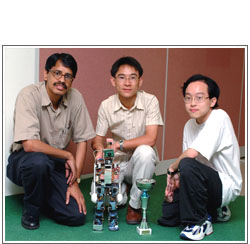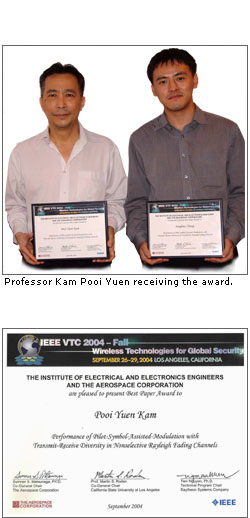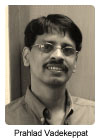Awards Gallery
Year 2004
- 2nd prize, FIRA Robot World Cup 2004, Busan, Korea
- Best Paper Award : Vehicular Technology Conference for Fall 2004, Los Angeles, USA

Dr. Prahlad Vadekeppat
2nd prize, FIRA Robot World Cup 2004,Busan, Korea
Humanoid robot (RoboSapien) has won 2nd prize at the FIRA Robot World Cup Busan 2004.
Humanoid Champion: RoboSapien
(Team members: Dr Prahlad Vadakkepat,
Mr. Zhuang Ruixiang and Mr. Tee Wei In)
A humaniod robot - named RoboSapien -
was recently developed at the Department
of Electrical and Computer Engineering
to investigate legged locomotion. Standing
46 cm tall and weighing 2 kg, the humaniod
is a 17 degrees of freedom structure.
The robot senses the environment through
a combination of eight force sensors,
one tilt sensor, an IR sensor, a digital
compass and a video camera.
RoboSapien participated in the FIRA Humanoid
robot championship where each humaniod
was required to compete in three tasks:
Robot Dash, Penality Kick and Obstacle
run.
In Robot Dash, RoboSapien covered the
stipulated 1.2 m long track in 25 seconds,
while the runner up took thrice that time.
In the penalty kick task, RoboSapien managed
to score 6 goals in 6 attempts. RoboSapien
outdid the competitors in the third and
the toughest of all tasks, the obstacle
run as well. Based on the performance
in all the three tasks, RoboSapien brought
home the overall championship trophy in
the FIRA Humaniod trophy in the FIRA Humaniod
Robot Competition.
Robot Soccer Champions: RoboLion
(Team members: Dr Prahlad Vadakkepat, Mr. Chan Kit Wai, Mr. Xiao Peng, Ms. Liu Xin)In a robot soccer system the robots are not controlled directly by humans. There are cameras installed for each team above the field, which are connected to the computers to enable computers to watch the match. Based on the strategy program, the computers make decisions and command the robots. The fundamental challenge is to program a good software to endow the robots with the capacity to cope with any unexpected occasions. Tools like fuzzy logic and neural network are utilized in the system. Real time robot path planning is carried out using evolutionary artificial potential field (EAPF). The parameters of the EAPF are optimized through multi-objective evolutionary algorithm.
RoboLion won second prize in the robot soccer competition at the 2002 Singapore Robotics Games. RoboLion also won second prize in the Benchmark competition at the FIFA Robot World Cup Beijing 2001. The Benchmark competition consists of a series of benchmark tests on precise motion, control and tracking of the robots and the ball.
------------------------------------------------------
For further information, please contact:
Dr. Prahlad Vadekeppat
Email: elepv@nus.edu.sg
Telephone: 6516 2296

Dr. Kam Pooi Yuen
Best Paper Award : Vehicular Technology Conference for Fall 2004, Los Angeles, USAProfessor Kam Pooi Yuen has been awarded with the Best Paper Award by the 2004 IEEE Vehicular Technology Conference on September 27, 2004, Los Angeles, USA.
Multiple-antenna systems, also known as multiple-input multiple-ouput (MIMO) systems, has been a hot research area in wireless communication for its impressive improvements in capacitiy and bit error rates (BER) over the conventional single-antenna systems. With a IMIO system employed, as in Fig. 1, the transmitted signals are weighted at different transmit antennas to pre-compensate for the channel fading, while at the receiver side the received signals from different receiving antennas are combined optimally to jointly produce an output for data detection. Compared with the conventional diversity reception or diversity transmission scheme, a MIMO system offers more individual transmit-receive (Tx-Rx) links, and could suppress the effects of fading more effectively.Most of the previous MIMO schemes proposed in the literature are, however, based on the idealized assumption that perfect channel state information is known prior to transmission at both sides of the system. In this award-winning paper, a simple yet efficient channel estimation system based on pilot-symbol-assisted-modulation (PSAM) is proposed, where known pilot symbols are periodically inserted into the transmitted signal sequence in different time-slots on different transmit antennas. Based on this channel estimation scheme, new optimum weighing criteria and strategies are developed for both the transmit and the receive antennas, and the resultant system error performance is examined.
The error performance of our PSAM-MIMO system clearly reveals the performance loss of a practical system due to channel estimation error, and enables the optimization of various PSAM parameters to provide a comprehensive design configuration.
Performance of Pilot-Symbol-Assisted-Modulation with Transmit-Receive Diversity in Nonselective Rayleigh Fading Channels
Abstract >> We investigate the error performance of
a wireless communication system employing
transmit-receive diversity in nonselective
Rayleigh fading channels using a pilot-symbol-assisted-modulation
(PSAM) technique. We first derive the
optimum receive weight vector using the
maximum likelihood detection principle,
and then the optimum transmit weight vector
based on minimization of the error probability.
Both sets of weights are optimal in the
presence of imperfect channel estimation.
New bit error probability results for
BPSK and QPSK are presented and the effects
of various parameters in the PSAM system
investigated.
2004 IEEE 60th Vehicular Technology
Conference, VTC2004-Fall
Publication Date: September 2004
Volume: 3, Issue 3 on page(s): 1840- 1844
------------------------------------------------------
For further information, please contact:
Dr. Kam Pooi Yuen
Email: elekampy@nus.edu.sg
Telephone: 6516 2122
|


